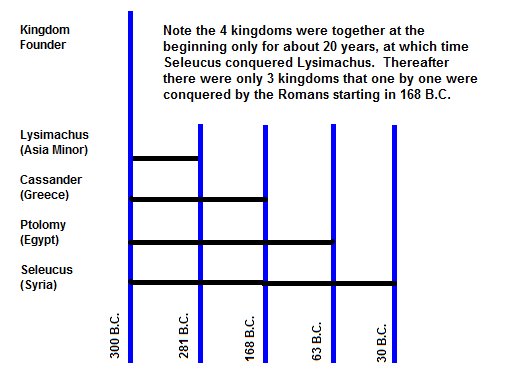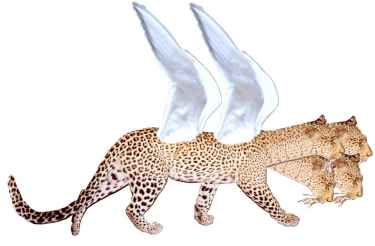Explanation of the Leopard of Daniel 7
Interpretation
Principles Used - Characteristics on leopard, move
from body to heads to go forward in time (Miller
Principle), concurrency of heads, similarity of
heads to the body, differences of heads and body. For
more information see Rules
of Interpretation of Daniel and Revelation
Daniel
7:6 - After
this I beheld, and lo another, like a leopard,
which had upon the back of it four wings of a fowl;
the beast had also four heads; and dominion was
given to it.
Click
on right arrow to go to next beast of
Daniel 7.
Note:
Time moves forward from left to right
Time
of the body -
The body represents the time of the empire of
Alexander the Great until
his death in Babylon in 323
BC. So
the body represents time before the empires
represented by the heads. The time of
the body and heads demonstrates the Miller
Principle.
Time
of the heads -
This time occurred after
the death of Alexander the Great in 323
BC and
is the time of the four kingdoms Alexander's
empire was split into. Note the four heads
represent time after the time of the body. The
vertical line to the left represents the point
in time where Alexander the Great died, which
represents the change from body to heads.
This
beast represents Greece (Macedonia). How
does the author know this beast represents Greece
(or Macedonia)? This beast is the third in
a series that represented kingdoms that began with
Babylon. It is known that Babylon (the
lion in the vision) was conquered by the Medes
and Persians (the bear in the vision), who in turn
were conquered by Alexander the Great's army (the
4 headed leopard in the vision). The sequence
of kingdoms tells the story. This changeover
from one dominant kingdom to another exemplifies
the Succession
Principle.
Four
wings suggest very rapid conquest (Characteristics
Principle). Note
they occur on the back of the leopard, indicating
they apply to the time represented by the body.
Alexander the Great did in fact conquer very rapidly,
just as the image above would suggest.
The
four heads clearly represent the time of the four
divisions of the empire originally created by Alexander
the Great. Note the four heads all occur together,
indicating the kingdoms also occur together and are
to be seen as concurrent with one another (Concurrency
Principle). The
heads and the body are all leopard, so likewise the
original kingdom was Grecian and the split up empire
was Grecian. One could say that the heads were
of a like nature to the body because the heads represented
political kingdoms or powers just like the body was
(Similarity
Principle). Note
the heads represented smaller, weaker kingdoms (Difference
Principle).
The
split up of the kingdom into 4 parts after the death
of Alexander the Great demonstrates the Miller Principle,
which says that the body of a beast with multiple
heads is used to represent the time
period of the initial kingdom (here
the initial kingdom was created by Alexander the Great),
and the multiple heads are used to represent the time
period of the kingdoms that follow afterwards,
which are a result of the breakup (or division of
power) of the initial kingdom. This demonstrates
the Miller
Principle.
Daniel
8 shows a goat that symbolizes the same thing as the
leopard. It says the following about it:
Dan
8:21 And
the rough goat is the king of Greece: and the great
horn that is between his eyes is the first king.
Dan
8:22 Now
that being broken, whereas four stood up for it, four
kingdoms shall stand up out of the nation, but not
in his power.
Why
Is a Leopard Used to Represent Greece?
Why
a leopard to represent Greece? After all, God
could have used a giant boa constrictor, or maybe
a hyena. Wouldn't a hyena look cool for a beast
here in the vision or dream, especially with 4 heads?
A hyena has some of the most powerful jaws in the
terrestrial animal kingdom so it surely would be seen
as a strong, fierce, cunning predator. But instead,
a leopard was used. As a predator a leopard
has to be very smart to survive. It is fast,
stealthy, and sneaks up on its prey and then suddenly
pounces on it. Sometimes it will hide in a tree
and wait for unsuspecting prey to come by underneath,
and it will drop down upon it and kill it. It
uses it's claws to hold the prey under control and
subdue it and then grasps the throat of its victim
with its sharp teeth to suffocate it, thereby attacking
the most vulnerable exposed part of the body of it's
prey. Death usually comes relatively rapidly
this way. Sometimes it will kill by biting the
back of the neck, with the intent of breaking the
neck. After the prey is dead, it will tear it
to shreds and consume it. This is comparable
to Alexander the Great, who was a very smart general
and possessed all of these characteristics (which
shows that the characteristics of the beasts do tell
us something about the behavior of a power, or what
a power would do, which is embodied in the Characteristics
Principle).
If
you would like to read of the first great battle that
Alexander the Great engaged in, including battle strategy, click
here. This
will give you some sense of his abilities. Click
here for reasons why Alexander used a feint attack
against the Persians to start the battle.
So,
as you can see, the first king (Alexander the Great)
is broken off (he dies) and four come up after him. In
history, when Alexander the Great died, his
half brother took the throne. Consequently,
there was a second king in this empire. But
he was mentally unstable and considered unfit to rule,
so military generals fought each other for the kingdom, but
finally divided it and parted ways. There were
seven top military commanders of Alexander the Great
who initially fought among themselves for the empire,
but in the end, only four got anything. The
seven have often been called the Diodachi.
The
four generals and the territories they took over
from Alexander the Great after his death were:
Cassander, who took Greece and Macedonia, Lysimachus,
who took Asia-minor (Thrace, Bithynia,
and Pergamum);
Ptolemy, who took Egypt, Libya, and Palestine;
and Seleucus, who took over Asia Minor, Syria,
and Persia which included Babylon. This 4
way split in the kingdom was complete by 300
BC. Note
that God shows only 4 heads on the leopard, yet it
is clear that there were five kingdoms initially.
Why show only four? The answer to this is that God
goes by decrees for dating changes in the beasts from
body to heads to horns. Since there was a decree in
300 BC between the four rulers but no decree before
that, only four heads are noted.
There
were 3 large divisions and a smaller one, but
this situation didn't last long. In 281
BC,
Seleucus attacked the kingdom ruled by Lysimachus and
defeated it. Thereafter, there were 3 kingdoms,
with the Seleucids in the north and the Ptolomies
in the south being the main players in the region
of Palestine. Cassander's kingdom was still
around (Cassander himself died in 297
BC)
but was in Greece and Macedonia. Greece itself
never again ruled the land of Israel after the
breakup of the empire into the four parts. The
battles between the generals was called the Diodach
Wars. Click
here if you would like to read about the Diodach Wars. Here
is another short but very readable history of the
Diodach Wars.
Click
here to see the chronology of:
The
Ptolomy (Hellenistic) empire (scroll
down to near the bottom just under GRECO-ROMAN
PERIOD)
Click
on each name below to see biographical information
about it:
Note
that this map may take a little time to load as it
is about 339K in size.
So,
as Daniel 8:21-22 said, the four came up (like the
horns on the goat), but "not
in his power". This
could mean Alexander the Great didn't determine
the succession to the throne. His generals did
that all on their own. Another possible meaning
of this phrase is that these kingdoms would be weaker
than the original kingdom.
The
graph below shows the 4 kingdoms and their dates of
fall. Note that 4 of them existed together for
only about 20 years, beginning in 300
BC.

One
thing that is of note is that historians in relatively
recent times (last 200 years), considered Macedonia
as part of Greece. They counted 4 provinces
of Greece which were Macedonia, Epirus, Achaia, and
Peloponnesus. However, Macedonia has a history
all its own, so more recent historians consider Macedonia
to have been a separate nation. Therefore, Macedonia
conquered Greece, then went on to conquer much of
the rest of the world to the south and east of Greece
and Macedonia. This did spread Greek culture
throughout the Middle East, so it probably is not
improper to consider this empire to be Greek in its
effects on much of the world it conquered. In
Daniel 8, the empire is referred to as Greek because
it is said that the horn on the goat represented the
king of Greece, which Alexander the Great certainly
was. Of course, he became king of a lot of other
countries before he was done.
There
is another aspect to this question. Alexander
was taught by Aristotle, which gave him a Greek education. One
result of that was that Alexander the Great adopted
a Greek way of life. So, it is natural that
Alexander would have spread Greek culture throughout
the regions that he conquered. Therefore, it
is reasonable to refer to this kingdom as Greek because
of its origins from both Macedonia and Greece, but
also because of its effects upon other kingdoms in
bringing in a Greek influence.
In
Daniel 8 a goat with first one and then four horns
is used to represent the Greek empires. Click
here to go to the explanation of the goat.


